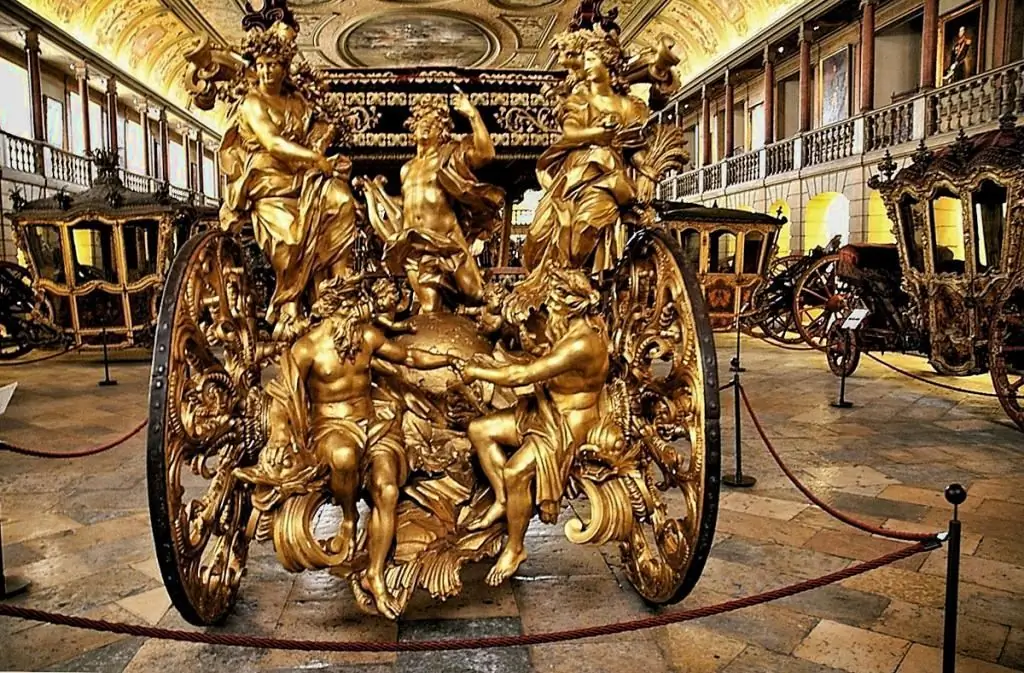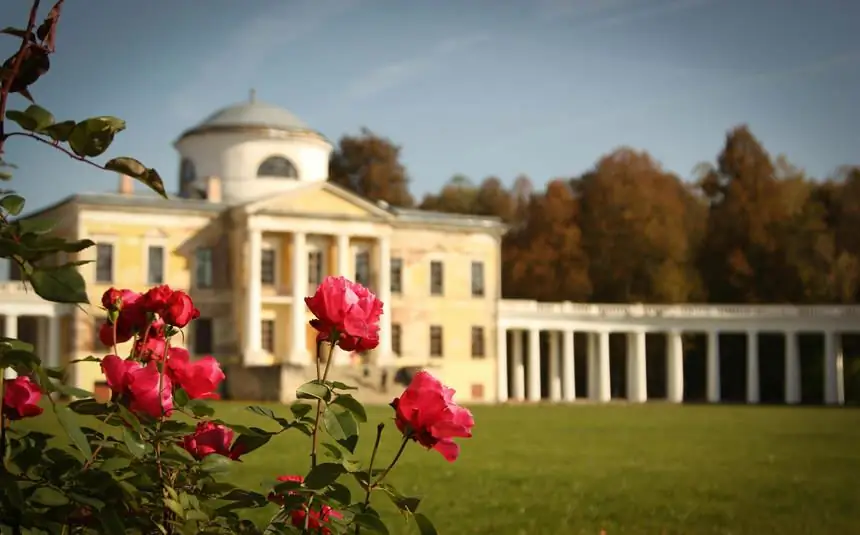- Author Harold Hamphrey [email protected].
- Public 2023-12-17 10:06.
- Last modified 2025-01-24 11:10.
Peryn Skete is a historical place on a beautiful island on the left bank of the Volkhov River, a few kilometers from Novgorod. It was used by ancient people, who in pagan times erected here the temple of the god of thunder Perun. Later, a Christian church was erected in its place and a monastic skete was founded.
History of the pagan sanctuary
The Peryn Skete is located in Veliky Novgorod, on an island measuring 400×200 m. After the construction of a dam on the river in the 1960s, the place became a peninsula. Historians suggest that in pagan times, the existing mound was absent in the Peryn tract, since according to the rules, the territory of the sanctuary should be separated from the burial place by water. However, chronicles from the late 900s mention the temple of Perun, the West Slavic god of thunder and lightning.
According to the chronicler in "The Tale of Bygone Years", the sanctuary was divided into 3 round areas, each of which was surrounded by a moat with water. In the center of each stood a pillar and pits were dug. In the center circle (largest)there was a high pillar on which the head of Perun was carved in a silver cap with a gilded mustache. Red stones were laid out around him. In other circles there were presumably also idols. According to pagan beliefs, these idols required human sacrifices, which is confirmed by the information of historians, according to which it was established that a Christian Varangian was killed here by pagans.

The arrival of Christianity
In this turbulent time, Prince Vladimir of Kyiv, together with his uncle Dobrynya, set as their goal the subjugation of the East Slavic lands to the capital of Kievan Rus. To do this, they sought to spread Christianity here.
In 989, the city of Veliky Novgorod was baptized with "fire and sword", christened it St. Joachim of Korsunyan. After that, the temple was destroyed, and the statue of Perun was thrown into the river. In 995, a wooden church was erected on this site, which stood for 200 years. Then the monastery was founded, which was then called Perun. In 1130, the Church of the Peryn Skete was built here in honor of the Nativity of the Virgin.
The documents indicate that in 1386 the Peryn Monastery suffered during the arrival of the troops of Dmitry Donskoy, and in 1552 there was a fire. The chronicles note that by 1623 the only elder named Maxim lived in the skete, who remained after the monastery and the temple were destroyed by the Swedish troops.

In 1634, Tsar Mikhail Fedorovich assigned the Peryn Skete to the nearby Yuriev Monastery by decree. In 1764 heabolished, but after 60 years it is reborn again. During the existence of the skete, its inhabitants always observed the charter of the ancient monasteries. For example, women were allowed here only once a year - on the feast of the Nativity of the Virgin, celebrated on September 21.
Skete in the 20th century
In the Soviet years, the island remained ownerless, back in the years of the revolution, warehouses of a fishing artel were made here. During the Great Patriotic War, the front line passed through the island.
Then, in the post-war years, a camp site was set up here, so many locals began to come here for the purpose of outdoor recreation: grilled barbecue, drank alcohol, etc.
Excavations on the island began in the 1930s, but the results were not discussed. The remains of the pagan temple were discovered by archaeologists in 1952, during the expedition of Artsikhovsky.
In 1991, the peninsula with the temple and buildings was transferred to the Russian Orthodox Church, and in the late 1990s the skete became part of St. George's Monastery. Restoration was carried out, after which the church was consecrated by the Archbishop of Novgorod and Starorussky Lev in 2001

Renewal of the skete in the 21st century
During the years of perestroika, a chaotic felling of old pines began here, which was stopped only after public intervention. The status of this place changed several times, and only since 2000 was it possible to restore order here, when Father Dmitry Baturo was appointed head of the Perynsky Skete (Veliky Novgorod).
First of all, the local monastic brothers startedpersistently and politely see wild tourists out and accustom them to comply with the rules of the charter. Signs were erected that prohibited camping and campfires.
Regular services began to be held in the temple, and now pilgrims come here. Tourists arriving from nearby regions of Russia, from European cities also like to visit this place.
Restoration of the facades of buildings and the church continues, the funds of the monastery go to it. Many people give help and respect to this place.
Territory and buildings
The area of the Peryn Skete is quite small. At the entrance there are wooden low gates, which can be entered only by bowing and “having humbled pride”. Inside there are several one-story buildings made of red brick. There are monks' cells (there are only a few of them) and guest rooms for visitors and pilgrims.
Long old pine trees rise all around. On the territory, the brothers under the command of Father Dmitry arranged a farm and vegetable gardens. Lake Ilmen stretches nearby, in which there are a lot of fish.
In the center of the skete stands a small snow-white church of the Nativity of the Virgin, crowned with a cross of an unusual shape. Several old frescoes have been preserved inside.

Nature and wildlife
Skit Island is located in the northern part of Priilmenye, at the place where the Volkhov River flows out of Lake Ilmen. Many water birds migrate here every year, migrating in certain months: gray herons, swans, etc.
The symbol of the Peryn Skete in Veliky Novgorod arespotted woodpeckers, which here easily find food in the form of pine seeds.
The animal world is represented by foxes, hares, martens and elk, whose tracks are clearly visible on the snow in winter. The island has fertile land, there are thickets of raspberries, bird cherry, nettles and celandine. The trees are mostly coniferous (larches, pines, fir), as well as wild apple and plum trees.

Church of the Nativity of the Virgin in the Peryn Skete
A small church with a bright gilded dome rises on a low hill on Skeet Island. It is considered the smallest in Russia, the width of its walls is only 9.5 and 7.5 m on different sides. So, going inside, you need to go only 5-6 steps to the altar. The Church of the Nativity of the Virgin was built in the characteristic style of Novgorod architecture, i.e. has a 3-blade completion of facades (zakomar). Such a constructive technique was used by the builders of the Nereditsa Church (1207) in Novgorod, and then here.
It is believed that the construction of a wooden church began 6 years after the baptism of Novgorod, it was founded by Archbishop Joachim Korsunyansky. And only at the beginning of the 13th century. (presumably in 1226) the church was built of stone.
The Church of the Nativity of the Virgin in the Peryn Skete was originally considered a monastery. Its cubic shape, high central vault (12 m) and lower side parts, as well as stonework, indicate the pre-Mongolian period. This form was typical for churches that began to be built already in the 14th century.
4-pillar interior structure with a singlean apse and a low sloping dome, tapering upwards, help to create the effect of aspiration upwards. The building has 3 wide entrances (now only one is open), which, together with the domed pillars, help to create the impression of a spacious and fairly tall building.
The cross above the dome in the shape of a crescent, which is also typical of the pre-Mongol period, its origin is taken from the "cross of the vine" (Christ considered his father a vinedresser). Near the Church of the Nativity of the Virgin, 3 brick buildings were built and survived to this day, where hermit monks lived.

History of submission to the church
At the beginning of the 19th c. Catherine the Second issued a decree on the abolition of the monastery and the founding of the Peryn skete of Novgorod, which already belonged to the St. George's monastery. This was due to the fact that St. Yuryevsky Monastery was located nearby, and then, according to tradition, fasting and silent worshipers went to the skete.
In 1826, at the direction of Archimandrite Photius, small brick buildings with cells were built for them. At the same time, pine trees were planted, which covered the skete from the wind from the side of Yuryevskaya Sloboda. The church operated until the October Revolution, and then the Soviet authorities closed the monastery. At the same time, services in the temple were held until 1920, while it was considered a parish, and only then it was closed.
The study of the church was started in 1947. However, during the years of the USSR, the temple was closed, and the buildings housed a tourist base. The restoration of the architectural monument took place in the 1960s. Then he took histhe original appearance, and after the excavations on the territory of the skete, the history and appearance of the ancient temple were established.
Now the church is active and belongs to the Novgorod diocese, like the skete.

How to get there
To get to the Peryn Skete, you need to leave the city. From the Novgorod Kremlin, located in the center, you need to go along the street. Meretskova Volosov, then turn onto the street. Kaberov-Vlasevskaya. Next, turn onto St. Orlovskaya and go to Yuryevskoe highway.

Following the road signs, go towards Yuryev. At the very beginning of the village on the right there will be a congress to the skete. This road will lead directly to the ancient gates of the monastery.
Also, buses number 7 and 7a from Novgorod (stop "Skeet") go here.
Monastery opening hours for visitors: from 6.00 to 22.30 in the summer, during the daytime throughout the year.






